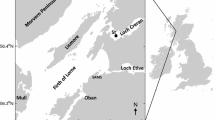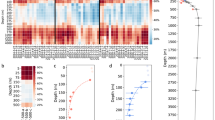Abstract
A new method is presented for measuring the rate of release of dissolved organic matter (DOM) produced by natural populations of marine phytoplankton. The method has been field-tested using natural populations of estuarine, coastal, and oceanic phytoplankton. Problems associated with the necessity for long incubation times, high initial activity of the inorganic 14C added to the sample, and self-absorption are overcome. Improved sensitivity is obtained by utilizing a large portion of the sample filtrate, Results from sampling at different times of day and for different lengths of incubation suggest that these problems should be reexamined in terms of both the percent and rate of relase of DOM from natural populations of phytoplankton. The rate of release of DOM from natural populations of marine phytoplankton decreases seaward. Phytoplankton in Georgia (USA) estuaries release <1 to 40 mg C m-3 day-1, in southeastern USA coastal waters from 0 to 19 mg C m-3 day-1, and in the westernmost Sargasso Sea from 0 to 2 mg C m-3 day-1. The percent of photoassimilated carbon released as DOM increases seaward. The percents are less than 7% in the Georgia estuaries, generally less than 13% in southeastern USA surface coastal waters, generally less than 21% for these coastal waters below the surface, and less than 44% for the westernmost Sargasso Sea. The results of this study and of other studies suggest that the measurement of primary productivity in estuarine and nearshore coastal waters is not seriously in error because of the absence of measurements on the rate of release of DOM from such phytoplankton. However, the estimation of primary-productivity values for oceanic waters is underestimated in some cases by about 50%.
Similar content being viewed by others
Literature cited
Anderson, G. C. and R. P. Zeutschel: Release of dissolved organic matter by marine phytoplankton in coastal and offshore areas of the Northeast Pacific Ocean. Limnol. Oceanogr. 15, 402–407 (1970).
Armstrong, F. A. J. and S. Tibbets: Photochemical combustion of organic matter in sea water, for nitrogen, phosphorus and carbon determination. J. mar. biol. Ass. U.K. 48, 143–152 (1968).
— and J. D. H. Strickland: Photooxidation of organic matter in sea water by ultraviolet radiation. Analytical and other applications Nature, Lond. 211, 481–483 (1966).
Beattie, J., C. Bricker and D. Garvin: Photolytic determination of trace amounts of organic material in water. Analyt. Chem. 33, 1890–1892 (1961).
Bray, G. A.: A simple efficient liquid scintillator for counting aqueous solutions in a liquid scintillation counter. Analyt. Biochem. 1, 279–285 (1960).
Duursma, E. K.: Dissolved organic carbon, nitrogen, and phosphorus in the sea. Neth. J. Sea Res. 1, 1–148 (1961).
—: The production of dissolved organic matter in the sea, as related to the primary gross production of organic matter. Neth. J. Sea Res. 2, 85–94 (1963).
Eppley, R. W. and P. R. Sloan: Carbon balance experiments with marine phytoplankton. J. Fish. Res. Bd Can. 22 (4), 1083–1097 (1965).
Fogg, G. E.: The production of extracellular nitrogenous substances by a blue-green alga. Proc. R. Soc. (Ser. B) 139, 372–397 (1952).
—: Extracellular products of the phytoplankton and the estimation of primary production. Rapp. P.-v. Réun. Cons. perm. int. Explor. Mer 144, 56–60 (1958).
— and W. D. Watt: Extracellular products of phytoplankton photosynthesis. Proc. R. Soc. (Ser. B). 162, 517–534 (1965).
— and W. D. Watt: The kinetics of release of extracellular products of photosynthesis by phytoplankton. In: Primary productivity in aquatic environments, pp 175–186. Ed. by C. R. Goldman. Berkely: University of California Press (1965).
Goldman, C. R.: Aquatic primary production. Am. Zool. 8 (1), 31–42 (1968).
Gullard, R. R. L. and P. J. Wangersky: The production of extra-cellular carbohydrates by some marine flagellates. Limnol. Oceanogr. 3, 449–454 (1958).
Harris, J. E. and L. Friedman: A rapid, inexpensive method for the decontamination of scintillation counting vials. Analyt. Biochem. 30, 199–202 (1969).
Hellebust, J. A.: Excretion of some organic compounds by marine phytoplankton. Limnol. Oceanogr. 10, 192–206 (1965).
Herberg, R. J.: Channels ratio method of quench correction in liquid scintillation counting. Tech. Bull Packard Instrument Co. 15, Downers Grove, Ill. 1965.
Horne, A. J., G. E. Fogg and D. J. Eagle: Studies in situ of the primary production of an earea of inshore Antarctic Sea. J. mar. biol. Ass. U.K. 49, 393–405 (1969).
Jitts, H. R.: Productivity. Division of Fisheries and Oceanography. Rep. Coun. scient. ind. Res. Aust. 1966–1967 p. 36 (1967).
Khailov, K. M. and Z. Z. Finenko: Organic macromolecular compounds dissolved in sea-water and their inclusion into food chains. In: Marine food chains, pp 6–18. Ed by J. H. Steele, Edinburgh Oliver and Boyd 1970.
Menzel, D. W. and R. F. Vaccaro: The measurement of dissolved organic and particulate carbon in sea water. Limnol. Oceanogr. 9, 138–142 (1964)
Nalewajko, C.: Photosynthesis and excretion in various algae. Limnol. Oceanogr. 11 (1), 1–10 (1966).
— and L. Marin: Extracellular production in relation to growth of four planktonic algae and of phytoplankton populations from Lake Ontario. Can. J. Bot. 47 (3), 405–413 (1969).
Passmann, J. M., N. S. Radin and J. A. D. Cooper: Liquid scintillation technique for measuring carbon-14-dioxide activity. Analyt. Chem. 28, 484–486 1956.
Poole, H. H. and W. G. R. Atkins: Photoelectric measurements of submarine illumination throught the year. J. mar. biol. Ass. U.K. 16, 297–324 (1929)
Provasoli, L.: Organic regulation of phytoplankton fertility. In: The sea, Vol. 2, pp 165–219. Ed. by M. N. Hill. New York: Interscience Publ. 1963.
Riley, G. A.: Organic aggregates in seawater and the dynamics of their formation and utilization. Limnol. Oceanogr. 8 (4) 372–381 (1963).
— P. J. Wangersky and D. van Hemert: Organic aggregates in tropical and subtropical surface waters of the North Atlantic Ocean. Limnol. Oceanogr. 9, 546–550 (1964).
Rodhe, W.: Can plankton production proceed during winter darkness in subarctic lakes? Verh. int. Verein theor. angew. Limnol. 12, 117–122 (1953)
Schelske, C. L. and E. P. Odum: Mechanisms maintaining high productivity in Georgia estuaries. Proc. Gulf Caribb. Fish. Inst. 14, 75–80 (1961).
Sen, N. and G. E. Fogg: Effects of glycollate on the growth of a planktonic Chlorella. J. exp. Bot. 17 417–425 (1966).
Steemann Nielsen, E.: The use of radioactive carbon (14C) for measuring organic production in the sea. J. Cons. perm. int. Explor. Mer 18, 117–140 (1952).
Stephens, G. C.: Dissolved organic material as a nutritional source for marine and estuarine invertebrates, In: Estuaries, pp 367–373. Ed. by G. H. Lauff. Washington, D.C.: American Association for the Advancement of Science 1967.
Strickland, J. D. H. and T. R. Parsons: A practical handbook of seawater analysis. Bull. Fish. Res. Bd Can. 167, 1–282 (1968).
Sutcliffe, W. H., E. R. Baylor and D. W. Menzel: Sea surface chemistry and langmuir circulation. Deep Sea Res. 10, 233–243 (1963).
Thomas, J. P.: Influence of the Altamaha River on primary production beyond the mouth of the river. M.S. Thesis, Univ. of Georgia, Athens, 46 pp, 1966.
Tolbert, N. E. and L. P. Zill: Excretion of glycolic acid by algae during photosynthesis. J. biol. Chem. 222, 895–906 (1956).
Walsh, G. E.: Studies on dissolved carbohydrate in Cape Cod waters. I. General Survey. Limnol. Oceanogr. 10, 570–576 (1965a).
— Studies on dissolved carbohydrate in Cape Cod waters. II. Diurnal fluctuations in Oyster Pond. Limnol. Oceanogr. 10, 577–582 (1965b).
— Vertical distribution of dissolved carbohydrate in the Sargasso Sea off Bermuda. Limnol. Oceanogr. 11, 406–408 (1966).
Wangersky, P. J.: The organic chemistry of sea water. Am Sci. 53, 358–374 (1965).
Watt, W. D.: Release of dissolved organic material from the cells of phytoplankton populations. Proc. R. Soc. (Ser. B) 164, 521–551 (1966).
— and G. E. Fogg: The kinetics of extracellular glycollate production by Chlorella pyrenoidosa. J. exp. Bot. 17, 117–134 (1966).
Williams, P. M.: The determination of dissolved organic carbon in seawater: A comparison of two methods. Limnol. Oceanogr. 14 (2), 297–298 (1969).
Wright, R. T.: Dynamics of a phytoplankton community in an ice-covered lake. Limnol. Oceanogr. 9, 163–197 (1964).
Author information
Authors and Affiliations
Additional information
Communicated by J. Bunt, Miami
Contribution No. 595 from the Department of Oceanography, University of Washington, Seattle, Washington, USA and Contribution No. 224 from the University of Georgia Marine Institute, Sapelo Island, Georgia, USA.
Extracted in part from a dissertation submitted to the Graduate Faculty of the University of Georgia in partial fulfillment of the requirements for the degree of Doctor of Philosophy.
Rights and permissions
About this article
Cite this article
Thomas, J.P. Release of dissolved organic matter from natural populations of marine phytoplankton. Marine Biology 11, 311–323 (1971). https://doi.org/10.1007/BF00352449
Accepted:
Issue Date:
DOI: https://doi.org/10.1007/BF00352449




